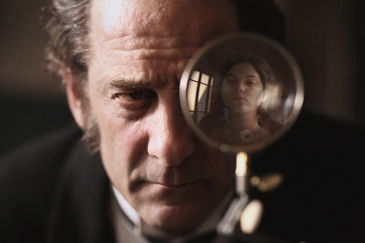Sex And Science Under Examination In Augustine
By Steven Pate in Arts & Entertainment on Jun 21, 2013 3:00PM
 "Don't bother praying," says one of the dozens of female patients to Augustine soon after she finds herself locked away in the the fortress-like Pitié-Salpêtrière hospital in Paris. "No one hears you here." The 19-year-old kitchen servant has come seeking relief from the partial paralysis and violent seizures that interfere with her work, only to find herself just one of the crowd of women confined there for any number of physical or psychological ailments shoehorned into an ancient and misogynistic diagnosis: "hysteria."
"Don't bother praying," says one of the dozens of female patients to Augustine soon after she finds herself locked away in the the fortress-like Pitié-Salpêtrière hospital in Paris. "No one hears you here." The 19-year-old kitchen servant has come seeking relief from the partial paralysis and violent seizures that interfere with her work, only to find herself just one of the crowd of women confined there for any number of physical or psychological ailments shoehorned into an ancient and misogynistic diagnosis: "hysteria."
Augustine's task now is to catch the eye of Jean-Martin Charcot, pioneer of neurology, Sigmund Freud's teacher and one of the most famous doctors in 19th-century France. Charcot is convinced that these symptoms have a physical cause that he must discover. Doing so will require the funding and support of the bigwigs of the scientific establishment, and so he needs a patient who can successfully demonstrate their condition to them. This means exhibiting a sometimes-naked woman like a circus animal before large audiences of captivated men, who watch as she is hypnotized and then triggered into her convulsions before erupting en masse into applause. Augustine seems to fit the bill perfectly.
The real-life Augustine was the most celebrated of the real-life Charcot's thousands of hysterics at Pitié-Salpêtrière and a celebrity likened to Sarah Bernhardt. In Alice Winocour's assured debut feature, Augustine, she seems to recognize quickly what sort of performances were required of her. Played with remarkable tenacity and poise by the baby-faced musician-turned-actor Soko, we witness the suffering, the longing, and the burgeoning self-assurance of Augustine as she recognizes that Charcot's need for her to exhibit her symptoms spectacularly is more important to him than his desire to cure her.
If recent controversies are any guide, determining what counts as a mental disorder remains as fraught today as ever. "Ovarian Hysteria" was one of the most diagnosed conditions in the 18th and 19th centuries, and even though the generation which followed Charcot's overwhelmingly ascribed to it a psychological rather than a physiological basis, the term didn't disappear from the Diagnostic and Statistical Manual of Mental Disorders until DSM-III (1980). Scientists today are still uncovering new evidence that the symptoms such as paralysis are demonstrably real. It is, above all, diagnosing the condition almost exclusively in women that seems the most shameful part of the condition's history now.
Turning a 19th-century psychiatric hospital into setting for a Gothic horror tale, Augustine employs the same flair for visual storytelling and ability to marry inner conflict to physical action present in Winocour's first short, 2005's Kitchen (there is, to put it mildly, no extraneous dialog or exposition in either work). Winocour's bold period piece offers a clinical inspection of Victorian mores and the power relationships embedded in the medical establishment from a contemporary vantage point.
Augustine opens today, June 21, at the Music Box, 3733 N. Southport Ave.